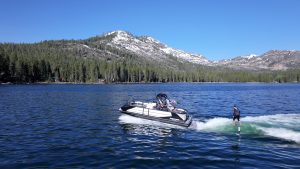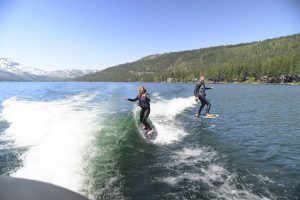Creating a wakesurf wave behind a boat involves a combination of factors including the boat’s hull design, speed, ballast, and trim settings. Here’s a breakdown of the process:
– Boat Selection: Wakesurfing boats typically have features designed to create a large, clean wake. These boats often have a V- drive configuration, which means the engine is placed at the back of the boat, allowing for more weight to be distributed towards the stern, where the wakesurf wave is generated.
– Ballast: Adding weight to the boat is essential for creating a sizable wakesurf wave. Ballast tanks, which can be filled with water or other heavy materials, are strategically placed throughout the boat to help create the desired wave shape. These tanks are often positioned towards the rear of the boat to help push the stern down and create a larger wave. This ballast helps displace more water and the more water that you displace, the bigger the wave. This can cause challenges with your boat having enough power, especially at altitude.
– Speed: The boat’s speed plays a crucial role in shaping the wakesurf wave. Generally, speeds between 9 to 14 mph are ideal for wakesurfing, but the exact speed may vary depending on the boat, ballast configuration, and rider preferences. Adjusting the boat’s speed allows for fine-tuning of the wave size and shape. Bigger boats tend to need a little more speed. Slowing down will shorten the wave while speeding up can elongate the wave. Some boats may shut off the surf system once you are going to fast and often you will have too much white water if you are going too slow.
– Trim Tabs and Wedges: Many wakesurf boats come equipped with trim tabs or wedges that can be adjusted to fine-tune the shape and size of the wakesurf wave. These tabs or wedges are typically located on the rear of the boat’s hull and can be raised or lowered to adjust the pitch of the boat, which affects the shape of the wake. Before these existed, we would put all our ballast and people in one corner to heavily list a boat. Now the touch of a screen does it on most boats.
– Tips: Just a couple tips to help you dial in your boat wave. More weight in the back typically brings the bow up and make your wave taller. Your boat will also have to use more power with more ballast or lead in your stern. More weight in the bow will make your wave longer, but too much can quickly cause you to loose forward energy in your wave. For foiling you should empty some ballast and mellow out your wave unless you want to do big airs or foil 10 waves back. Yes that is possible.
– Surf Boat: You do not have to use a boat designed for surfing. You can build your own surf system using manual ballast bags, lead and a suction cup shaper for the side of the boat. This is a bit more work and takes some extra knowledge of building a wave behind a boat, but this is where SnF Tahoe can be a big help. Call them! It may be more work, but it can easily save you $100k. Or pay the extra money, touch a button and surf your little heart out!
– Fine-tuning: Once the basic setup is in place, small adjustments can be made to fine-tune the wakesurf wave. This might include redistributing weight within the boat, adjusting the boat’s trim, or experimenting with different speeds to achieve the desired wave shape and size. You can save a lot of headache by hiring a professional like Surf n’ Foil Tahoe. They can help dial in your wave quickly and help you understand how to tune it yourself when out with friends, because weight is always changing in your boat and so will your wave.
Overall, creating a wakesurf wave behind a boat involves a combination of careful boat setup, weight distribution, speed control, and fine-tuning to produce a safe and enjoyable surfing experience.


Surf n Foil Donner Lake
